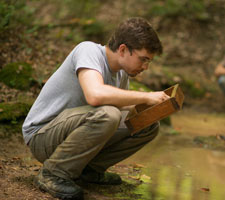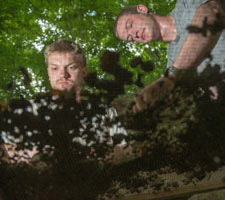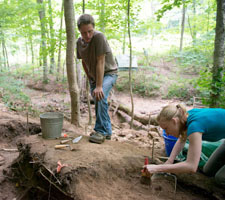By Angela Woodward
Ten Ohio University students are spending the summer unearthing prehistoric artifacts – more than 1,000 years old – and analyzing their finds through the Ohio University Archaeological Field School.
One of only a few such programs offered in the state of Ohio, the field school gives students an opportunity to participate in a hands-on experience that allows them to be a part of the entire archaeological process.

Daniel Williams, a student participating in the Ohio University Archaeological Field School, looks for bone fragments.
Photographer: Ben Wirtz Siegel
“This is actual hands-on research,” explained Paul Patton, an adjunct anthropology faculty member in the College of Arts and Sciences. Patton, an OHIO graduate who earned a master’s degree in environmental studies with a focus on environmental archaeology in 2007, participated in the field school in 2004 and is directing this year’s school. “These students are participating in the whole process of doing primary research in archaeology, and they are getting in essence a higher level of breadth in their education.”
Established in 1986 by Professor Elliot Abrams, the Ohio University Archaeological Field School is offered every other summer. This year’s field school began May 13 and includes the excavation of a rock shelter on property owned by Patton’s family located a few miles west of Athens.
“This is something I really look forward to,” Patton said of the field school. “It gets the students out of the classroom and allows me to form a closer relationship with them.”
The rock shelter the students have been excavating – also known as “Patton’s Cave” – is where Patton’s grandfather discovered artifacts about three years ago. A preliminary excavation of the site conducted by OHIO students led to the discovery of a number of tools, charcoal and pottery – and resulted in the site being deemed suitable for further excavation.
The past two OHIO field schools have been held on the property and have turned up numerous artifacts from the Late Woodland era (400-1000 A.D.). This year’s dig has unearthed several thermal features, bones with dog chew marks on them suggesting dogs were used in hunting, and chert, a flint-like material often used to make stone tools.

Students (from left) William Cameron and John Gaynor sort through debris using a wire mesh screen during the Ohio University Archaeological Field School, a summer program offered by the Department of Sociology and Anthropology.
Photographer: Ben Wirtz Siegel
John Gaynor, a senior anthropology major from Cincinnati, said one of the best finds of this year’s dig was a drill bit made of chert.
Tatiana Fox, a senior psychology and classical civilizations major from Bowling Green, said the group also uncovered a ground stone that had been worn down from use, allowing the students to see exactly how the instrument was held by a Native American. She noted that one side of the ground stone was purposefully modified and the students could see an indentation where the tool was likely used for crushing nuts.
“This has been a great experience. I just absolutely love hands-on work,” Fox said.
Daniel Williams, an environmental and plant biology major from Dayton who just completed his fifth year at OHIO, said he enrolled in the field school because of his interest in sustainability.
“There are no people who learned to live more sustainably than the Native Americans,” Williams said. “And the best way to learn about how they lived in a sustainable way is to dig up what remains of their habitat and analyze it.”
“This program has given me a greater understanding of what I want to do in regards to anthropology,” said Olivia McCuskey, a senior anthropology major from St. Albans, W.Va. “It also gives me a greater understanding of how our ancestors lived and how they used every part of the woods.”
In addition to learning the ins and outs of the archaeological research process, Patton said the field school helps students develop team skills and provides them with an understanding of the scientific process and how the scientific record is created.
“This experience helps them develop a higher range of intellectual thinking and critical thinking skills,” Patton explained. “And I think that anytime we can incorporate the scientific method into hypothesis testing we’re producing better students.”
William Cameron, a senior political science major from Columbus, didn’t enroll in the field school to fulfill a college requirement, but rather “to have an out-of-the-box class experience.”

Student Tatiana Fox (right) participates in the Ohio University Archaeological Field School directed by Paul Patton (left), an adjunct anthropology faculty member in the College of Arts and Sciences.
Photographer: Ben Wirtz Siegel
“We’re outside, digging, doing physical work. You don’t get that in most classes,” Cameron said. “I’ve learned a lot about Ohio’s pre-history. … It’s a unique experience that not many others will have, and it has improved my ability to be technical and analytical.”
The field school is composed of two parts designed to cover all stages of archaeological research, from design to survey mapping to excavation techniques and laboratory methods. The students will spend another week excavating before moving to the laboratory where they will analyze the artifacts and other items they’ve uncovered and develop a formal report about their findings.
In addition to earning college credit, the students enrolled in the field school will have an experience that few of their peers will have had and one that could help them land an internship or job.
“This program has been very successful in helping students who are interested in going into the field of archaeology,” Patton said.
According to Patton, the private sector of archaeology is very active in the United States. He explained that anytime federal money is used to develop land, Section 106 of the National Historic Preservation Act is implemented. Section 106 identifies steps that must be taken to identify historic sites, to predict the effects of development on those sites, and then to mitigate the negative effects that could occur. Those assessments are generally handed over to private firms, also known as cultural resource management (CRM) firms.
“This field school has given students the skills they need to compete for those jobs, and we have had a number of our students go on to CRMs,” Patton said.
In fact, Patton noted that the day he was going into his final exam at OHIO he received a phone call from a CRM firm wanting to know if he would come to work for them the very next day.
Patton said as the U.S. economy improves and development picks up, he anticipates the need for archaeology professionals to increase as well.
“This seems to be the beginning of another big swing of archaeological jobs that are going to be opening, and the students who participate in this field school should be prepared to go out in the field on Day One,” Patton said.


















Comments